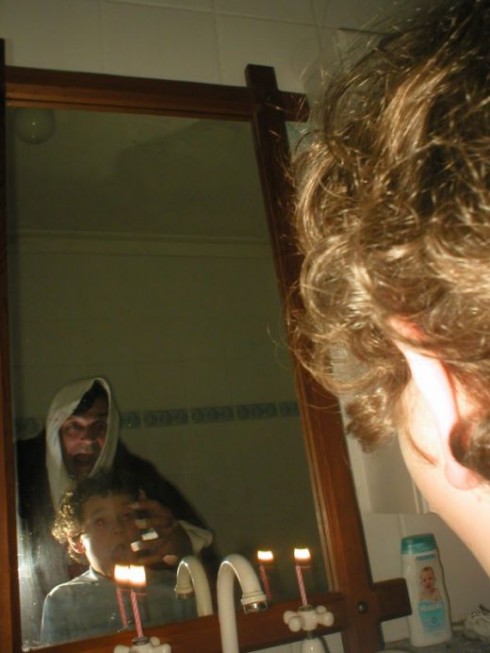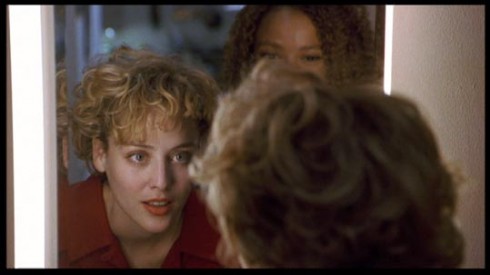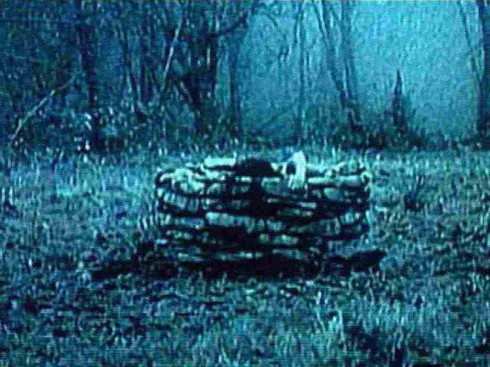The Reality Of The Situation
 When I was a boy, I was unnerved by graveyards. It wasn’t that I was expecting a ghost to come rambling up from amongst the headstones, it was more the mental image of so many corpses, in various states of decomposition, so close underfoot.
When I was a boy, I was unnerved by graveyards. It wasn’t that I was expecting a ghost to come rambling up from amongst the headstones, it was more the mental image of so many corpses, in various states of decomposition, so close underfoot.
Legend tripping, also known as ostension, is a name recently bestowed by folklorists and anthropologists on an adolescent practice (containing elements of a rite of passage) in which a usually furtive nocturnal pilgrimage is made to a site which is alleged to have been the scene of some tragic, horrific, and possibly supernatural event or haunting.
It’s easy to dismiss weird tales, and such night-time adventures, as simply titilation for the morbidly-curious, but, as I’ve mentioned previously, it’s my contention that such bits of odd ritual play an important role in our social development.
The concept of legend tripping is at least as old as Mark Twain’s 1876 The Adventures of Tom Sawyer, which contains several accounts of adolescents visiting allegedly haunted houses and caves said to be the lairs of criminals. Tom Sawyer is based on lore that was current in Twain’s own boyhood, and by Twain’s time the main features of the ritual were already in place.
It seems obvious to me that this sort of thing was going on well before Twain’s time – likely as long as we’ve been sitting around fires, swapping tales, or coming across caves and copses that, for reasons beyond our understanding, set us on edge.
Despite not understanding the source of their thrill, I believe every tipped gravestone is a rude-finger in the direction of the vandal’s inevitable death, and every climbed step in a haunted house is another proof to the adventurer that the reaper’s grasp is limited, and possibly even defiable.

Of course, not all such adventures end in back-patting and story telling, and not all dangers involved are supernatural.
Frances G. Reinehr’s 1989 book [Bloody Mary] tells the true story of long-time Lincoln resident Mary Partington, who became known as “Bloody Mary.” Mary’s old-fashioned dress and her house with no electricity caught the attention of area teenagers, who made a sport out of taunting and harassing her. Mary received her cruel nickname after shooting and killing a youth who attempted to break into her house. She was not charged with a crime on the grounds of self-defense.
What will be interesting to see, in the coming century, is how these legends, and challenges, change.
Just as “The Phantom Hitchhiker” is no longer mounting a carriage, will we one day see something akin to a haunted forum? A blog at which it is said the occasional viewer sees a message from the dead – a message which eventually spells their doom?
Will preteens, tucked into sleeping bags and gathered around the glow of a netbook, one day giggle nervously over a cursed registration page?

Wikipedia strikes again with all the authority of a newt. Although it goes back even further, you can find reference after reference after reference to the same thing in classical Greek literature, and Gothic literature, and pretty much any other time in any other place. All that is changed is that some alleged academic gave it a name so as to justify his grant and makse some sort of “contribution” to a field where it has all been covered long before he wandered by. Names like that get picked up by hipster doofuses eager to make themselves sound like they are doing something cooler than just visiting a cemetary. It is just a way of making it sound like they are members of some exclusive genre. Dumb names like that accomplish absolutely zero except to be exclusionary.
“Oh, you were at the cemetary yesterday? I’ve been legend tripping there for years.” (smug grin, tries to act cool)
“I was just bestowed a grant from the Columbia Foundation for my theories of ostension.” (smug grin, tries to act superior, secure in the knowledge that average person has no clue what ostension is or he’d get laughed at)
Did I go off topic? Sorry. I hate that kind of exclusionary pseudo-superiority crap.
Well, I do see your point, but I wonder if it has more to do with the fact that, up until relatively recently, whatever you’d like to call it was was largely considered child’s play, hardly worth academic consideration (or naming)?
Both “legend tripping”, and “ostension”, strike me as a little silly, but it’s definitely an area I’d like to see receive greater consideration and research, whatever the label. (If only because I love reading about such tales.)
The problem is they aren’t so much researching the tales (which would be cool) as they are the psychology or science behind the behavior of going to haunted places, which can be summed by this lay person as “people like scary things” and I didn’t even need a degree for that. I don’t think that every little foible of human nature needs to be- or can be- quantified to the eighth decimal point. It is like an acedemic version of sniglets, comming up with names for things that didn’t need a name to begin wtih.
Fair enough – although I do feel like a lot of interest in the subject can be related back to the work of Dr. Jan Harold Brunvand, and, while I don’t know if his doctorate is in fakie-ology, I do have a lot of respect (and love) for the folktale collections he’s put out.
I used to have a few of his books, now I wish I kept them.
I think I am going to cite this post for my thesis. I am about to become a Doctor of Blogument Inquisitivity.
Oddly, this is the second time this week that someone has mentioned using flashpulp.com for academic purposes, and the first was even being serious.
what an interesting thought! I’m so curious as to how our fables will change in the coming generations.
And now i want to create a haunted website…just for fun.
Oooh, let me know if you actually want to move forward with a pseudo-haunted website, might be a fun Halloween project.
Just out of curiosity (and because your post reminded me of it), have you read/seen the story about the guy who bought an N64 and a haunted Legend of Zelda: Majora’s Mask cart?
I don’t know the full story.. apparently because my boyfriend (who *KNOWS* these things) said it was so damn creepy I wouldn’t be able to bear it. Which is probably very accurate, I am “that person” who is afraid of things that go bump in the night.. even if more than half those bumps are just figments of my imagination.
Very interesting – googling it.
Ah, very neat. I think it’s the combination of the familiar, (at least to gamers,) with unexpected deviations, that makes the haunted Zelda videos effective.
Good stuff – it actually reminds me of an old tale I recall being circulated, regarding a haunted painting that went up on ebay.
Here’s an image of the picture:
http://www.castleofspirits.com/hp1lrg.jpg
– and a bit of history from http://www.castleofspirits.com/hauntedpainting.html
“In February, 2000 the sudden appearance of a rather strange painting with the accompanying title of “Haunted Painting” made it’s debut on Ebay.com. Of course a title like this is going to attract attention and it’s still discussed to this day whether the painting is genuinely haunted or not. Even stranger is the reactions that the general public had when viewing the photos of the painting.”
GAH. That painting is terrifying. Period. LoL, creepy children very creepy! Not to mention, there’s just something about the medium of paint on canvas that adds an air of malice and/or dread to certain images.
I can’t remember the name of the painting–but I believe it might have been one of Dali’s–that scared me so bad after I realized what was being depicted, I completely revamped an entire art history project just so I wouldn’t have to continue looking at it.
Hah – Jessica May feels much the same way about creepy children, even our own spawn terrify her if it’s a shadowy room.
I could definitely see the right Dali piece being terrifying, his mix of religion and surrealism provided some pretty fertile turf.